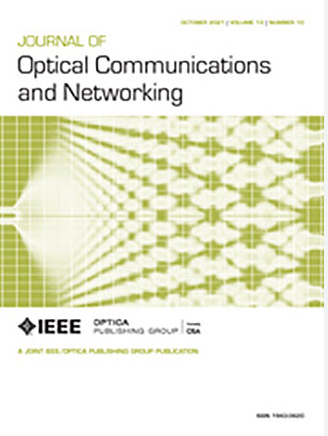瑞士国家时间尺度UTC(CH)通过白兔在电信光纤网络中的长距离传播
IF 4.3
2区 计算机科学
Q1 COMPUTER SCIENCE, HARDWARE & ARCHITECTURE
引用次数: 0
摘要
白兔已经成为一种很有前途的时间尺度传播技术,为卫星技术提供了弹性。为了在白兔网络中实现亚纳秒级别的最先进的同步性,需要对物理效应、组件和参考时间尺度进行完整的表征,以消除白兔协议无法补偿的系统偏移。由于这种复杂性,只有少数远程白兔网络可以在亚纳秒级别上声称与国家时间尺度同步。我们在这里展示这样一个网络,其使命是传播瑞士官方时间尺度UTC(CH)。为此,在已部署的覆盖近500公里光纤的电信光纤网络的l波段,将白兔网络层复用为两个暗信道。我们在稳定性和精度方面对其性能进行了表征,发现不确定度为289-415 ps。这验证了其在亚纳秒精度和精度水平上传播UTC(CH)的潜力。结果证实,白兔提供了必要的性能来分配和比较国家时间尺度UTC(CH)在光纤网络上的国家和最终在国际层面。本文章由计算机程序翻译,如有差异,请以英文原文为准。
Long-haul dissemination of the Swiss national time-scale UTC(CH) in a telecommunication fiber network via White Rabbit
White Rabbit has emerged as a promising technology for time-scale dissemination, providing resilience to satellite techniques. To achieve state-of-the-art synchronicity at the sub-nanosecond level in a White Rabbit network, a complete characterization of physical effects, components, and the reference time scale is required in order to remove systematic offsets not compensated by the White Rabbit protocol. Due to this complexity, only a few long-range White Rabbit networks can claim synchronicity to a national time scale on a sub-nanosecond level. We present here such a network with the vocation to disseminate the Swiss official time-scale UTC(CH). To that end, the White Rabbit network layer is multiplexed into two dark channels in the L-band of a deployed telecommunication fiber network covering nearly 500 km of fiber. We characterize its performance in terms of stability and accuracy and find an uncertainty of 289–415 ps. This validates its potential to disseminate UTC(CH) at the sub-nanosecond accuracy and precision level. The results confirm that White Rabbit provides the necessary performance to distribute and compare the national time-scale UTC(CH) over optical fiber networks at the national and eventually at international levels.
求助全文
通过发布文献求助,成功后即可免费获取论文全文。
去求助
来源期刊
CiteScore
9.40
自引率
16.00%
发文量
104
审稿时长
4 months
期刊介绍:
The scope of the Journal includes advances in the state-of-the-art of optical networking science, technology, and engineering. Both theoretical contributions (including new techniques, concepts, analyses, and economic studies) and practical contributions (including optical networking experiments, prototypes, and new applications) are encouraged. Subareas of interest include the architecture and design of optical networks, optical network survivability and security, software-defined optical networking, elastic optical networks, data and control plane advances, network management related innovation, and optical access networks. Enabling technologies and their applications are suitable topics only if the results are shown to directly impact optical networking beyond simple point-to-point networks.

 求助内容:
求助内容: 应助结果提醒方式:
应助结果提醒方式:


